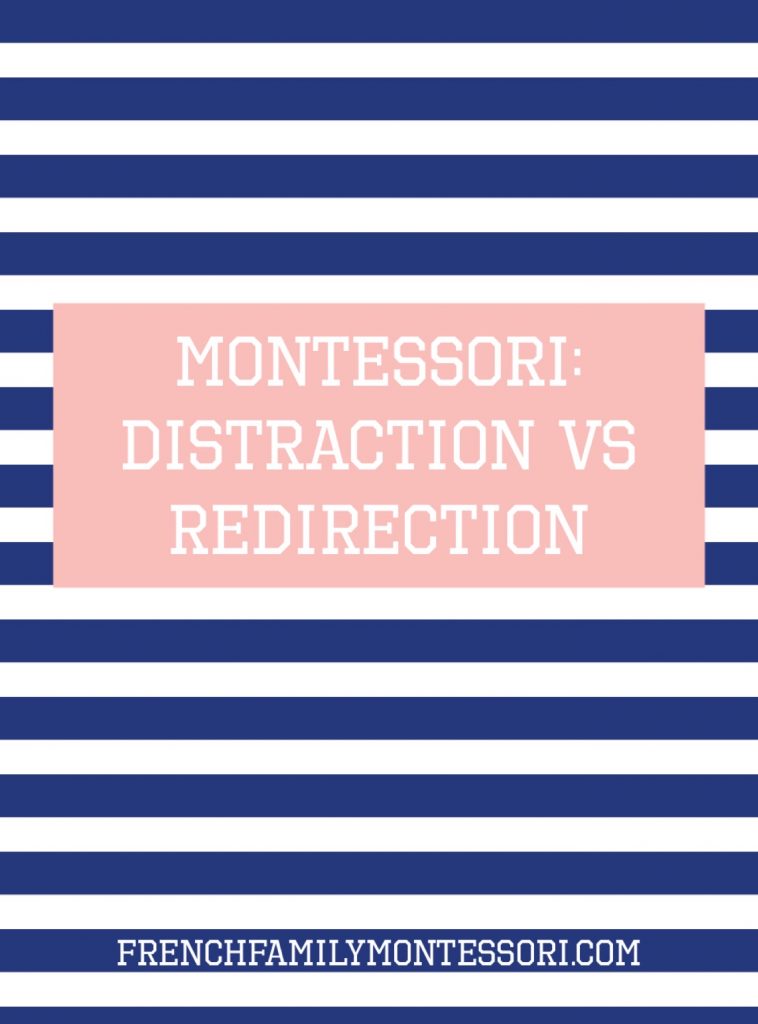
Distraction and redirection may seem similar, but they are actually rather different. Both are meant to shift actions. One takes the actions of the child and provides them with appropriate alternatives and explanations. The other is purely meant to entertain or divert attention. If you look up “distract” in the thesaurus, you will find the synonyms: bewilder, disturb, entertain, perplex, and mislead. Not exactly words that necessary align with the Montessori philosophy.
When redirecting, we take the child’s actions and assist them in learning where and when that particular action is best suited. It’s helping a child learn boundaries and rules.
The girls love to read. They are also still exploring much my mouth. While this doesn’t seem like big deal, they now have teeth that are destroying their books. This is not how we treat these materials. They have a natural desire to chew, so when they place a book in their mouth, we respect this need and provide them something appropriate for chewing, a teether. On Mondays we explore musical instruments. Some, like the jingle bells, aren’t safe for mouthing. If I redirect to a teether a few times and they still wish to put that instrument in their mouth, it is time to put that particular item up for the time being. While we respect their need to chew, it is still our responsibility to make sure that they are safe and treat materials appropriately.
When T threw a Lincoln Log, I would explain that Lincoln Logs aren’t meant for throwing, they are for building. We also don’t throw items in the house, as I’m concerned that something may be broken or someone harmed. But balls are for throwing. So we would take a ball outside, where throwing is safe and encouraged.
When he wanted to climb on furniture or jump on the sofa, we created an obstacle course. We also used cards that had different actions for him to recreate- hopping like a bunny and waddling like a penguin to name a few (here is something I plan on getting the girls that seems similar, along with this one).

If a child is using an object to hit, there are two different approaches we use, depending if it’s an object or person that is being hit. If it’s a person, we first comfort the injured party and then explain that we can’t allow them to harm someone. If it’s an object, we explain that these materials aren’t being used for their intended purpose. It is, however, completely acceptable to hit a ball with a bat. (Having a set with a tee, such as this one or this, helps make it so that the child is able to use and meet this desire with little to no assistance.) Depending on age and development, a pounding set (we love this one and this one with a foam block for an older toddler ) or drum are also great redirecting options. If hitting is a regular occurrence, intentional building with a hammer and nails, such as making a bird feeder, may help fulfill their desire.
I would like to clarify that just because we try to redirect, does not mean that we never use the word “no”. We just prefer to conserve it for more serious or life threatening situations. We don’t want to overuse it, so when they hear it, it grabs their attention immediately.
What would some instances of distractions be and are they ever appropriate in a Montessori home?
An infant who is upset because they want something and a caregiver using a rattle to pacify them is one example of a distraction. We aren’t acknowledging the child’s emotions or needs, but rather diverting their attention to material that has nothing to do with the situation.
A sitter who preoccupies a child so that their parents may slip out the door is another example. While it may be tough to leave a child they may be just as upset, if not more so, when it is discovered that their parents snuck out. While distressing, it is better to give proper goodbyes. How can we redirect in this type of situation? First, acknowledge the child’s feelings. Then offer if there is something that they may fancy while their parents are enjoying themselves. “I see you are upset that your parents are leaving for a few hours. They said they would return at 8; let’s find a clock so that you can see when that will be. After we locate a clock, is there an activity that you would enjoy or maybe you’d like to go for a walk or read a book?”
Recently, when E was breaking two teeth at once, she had a hard time focusing on any of her materials, didn’t want to cuddle or read, and she still wanted movement. So we organized the kitchen cabinets. Listening to music and exploring completely different kitchen items was the perfect way to distract her from her mouth. Why is this considered an acceptable form of distraction? Because, ultimately, there was no option of redirecting. The pain wasn’t something that required guidance, was being inflicted by something uncontrollable, and other forms of pain relief had been exhausted.
There are times when children are distracted by their environment, like the ceiling fan or lights, and it is what it is.
How does your family handle redirecting and distractions?
Disclosure: French Family Montessori uses affiliated links through Amazon. There is no additional cost to you, but provides a small compensation that helps support this site. I will only share products that we use or have used ourselves or have on our wish list. There is no obligation to purchase an item through an affiliated link.

One thought on “MONTESSORI: DISTRATION VS REDIRECTION”